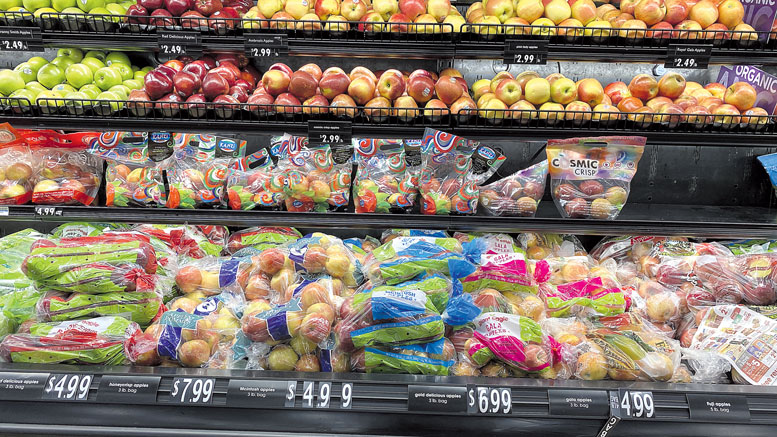Eastern Apples: Great Crop, But Marketing Challenge
August 27, 2024 | 8 min to read
Eastern apple growers are optimistic about a large harvest despite weather challenges. With production up in New York and stability in Pennsylvania and Virginia, the crop is promising for retail. Increased consumer curiosity about unique apple varieties drives innovation, with marketing strategies emphasizing peak flavors and health benefits. Retailers are encouraged to showcase various types, enhance displays, and offer tasting opportunities to boost sales and educate customers on diverse flavor profiles.

PHOTO COURTESY BAUGHER’S ORCHARDS AND FARMS
Promoting Eastern-grown apples on the East Coast is a great advantage.
Although weather-related challenges hit some parts of the region, Eastern apple growers had a spring that promises a large crop, which could be good for retail even if it may be rough on growers.
As is the case elsewhere in the United States, Eastern apple growers are looking to harvest a lot of fruit, says Lynsee Gibbons, director of communications, U.S. Apple Association, Falls Church, VA.
“New York is back on track, up around 5% from last year,” she says, “and Pennsylvania and Virginia are projected to be around the same as last year, maybe a little less. Keep in mind, last year was a big year, the highest production we’ve seen since USDA started tracking.”
Brenda Briggs, vice president of sales and marketing, Rice Fruit Co., Gardners, PA, says the apple crop for 2024-25 is on a solid foundation.
“This year’s apple crop prospects look exceptionally promising in the Eastern region,” she says. “We are observing that the fruit size is ahead of last year at this time. This early development is a positive indicator of a strong season ahead. While the weather is heating up, which is beneficial for fruit growth, irrigation will play a crucial role in maintaining the health and quality of our orchards through the hotter weeks.”
Todd Kirmss, who operates Holt Orchards, Flat Rock, NC, says, early days in the growing year were promising.
“Our farm’s apple crop is looking good,” he says, “We have dodged extreme temperatures and hail so far. Unfortunately, there are a lot of apples from last season in cold storage, and we are hearing that no one will need apples this year. This news keeps us up at night, trying to figure out what we will do with a crop that we can’t sell. We have already spent a lot of money on pruning, chemicals and farm maintenance. The apples still have to come off trees, so labor costs are still there. These are the times we wonder why we do this.”

PRODUCE BUSINESS/SUSAN CROWELL PHOTO
Apple growers face a significant amount of up-front investment to modernize operations with advanced precision agriculture techniques, software analytics and other methods to reduce input costs per acre and maximize yield per acre, Gibbons says. For some growers, the effort has become too much.
“Sadly, many growers have gotten out of the business due to higher input costs and lower returns,” says Gibbons. “The rapid escalation of labor costs over the last decade is a large contributing factor to this.”
INNOVATION AND FLEXIBILITY
Briggs says that Rice Fruit is emphasizing harvest management strategies, especially for the more labor-intensive apple varieties such as Honeycrisp.
“There is a delicate balance between fruit maturity, color and handling, mainly as growers are eager to begin first picks,” she says. “We rely on strong communication with our growers and precise attention to the crop to determine what should be picked and when. This practice ensures that fruit is at the peak of flavor.”
Growers continuously evaluate their varietal mix to stay ahead of consumer preferences and market trends, Briggs notes. “We have seen an increase in the acreage of newer varieties such as Lemonade, SnapDragon and Evercrisp. These innovative varieties are gaining popularity for their unique flavors and exceptional eating qualities.”
Flexibility is important, she adds.
“The landscape of the apple industry is always evolving, and our commitment to quality, innovation and sustainability remains unwavering, ensuring that we continue to provide the freshest, most delicious apples to our customers,” says Briggs.
Among the biggest apple producing states, New York is preparing for a larger-than-usual harvest. The New York Apple Association (NYAA), Fishers, NY, predicts the state will produce 32,500-32,700 bushels of apples this year.
Michael Wallace, director of communications, Virginia Department of Agriculture and Consumer Service, Richmond, VA, says, the outlook in his region has been influenced by labor and other input cost challenges, but no radical change is occurring.
“While the overall acreage has not drastically changed within the last five to 10 years, there has been some consolidation. Producers are growing some newer varieties, however more established varieties such as Golden Delicious, Lodi and Granny Smith remain consumer favorites,” he says.
Spring started off well in Old Dominion, says Laura Wiley, executive secretary, Virginia State Horticultural Society, “then we went into a season of drought. Now, we’ve got a reduced sized crop. So, in that scenario, your fruit’s not as big. It tends to be sweeter, but it’s not as big.”
EAST SIDE STORY
The range of apples available from the East is vast, and includes local and regional favorites and even exclusives such as New York’s SnapDragon variety, so matching fruit and taste expectations can be readily accomplished. As apple season approaches, retailers might consider gradually raising the category’s profile and trying out some new varieties and flavor profiles to generate consumer curiosity.
Briggs says merchandising should take into consideration the evolution of the apple sector.
“The apple category is seeing greater emphasis on the differentiation between varieties,” she says. “Core varieties like Gala and Fuji are immensely popular, but launching new varieties is a constant challenge. With an influx of branded varieties, shoppers are being introduced to names and flavors, though the apples may look the same: a bi-color blend that tends to confuse even the keenest eye.”

PRODUCE BUSINESS/MIKE DUFF PHOTO
The company does all it can to set things retailers up for success, such as the PLU sticker on bulk fruit or the packaging for its bagged apples. For instance, Briggs says Lemonade has bright blue and yellow packaging, “the perfect contrast amid the sea of red bi-colored apples. And if the packaging does its job, then it’s up to the apple. We’re confident that if the shopper tries it, they’ll be back and know what to look for.
“We have seen an increase in consumer curiosity. Where does my food come from? How is it grown? Who is the farmer? Promoting our prominent regionality on the East Coast is a great advantage to Rice Fruit Co.,” she says.
Because both variety and eye appeal are part of apple merchandising, retailers can benefit from consistently focusing on what’s moving, how that’s changing and optimizing the presentation accordingly.
“Retailers should aim to include a minimum of five to seven varieties to cater to diverse consumer preferences,” says Briggs. “Bulk displays and regional or locally grown apples are significant, but it’s equally important to clearly distinguish between varieties and provide point-of-sale information about flavor profiles. This helps consumers make informed choices and enhances their overall satisfaction with the product.”
Cynthia Haskins, NYAA president and chief executive, says emphasizing health benefits can give consumers yet another reason to purchase, so the NYAA is making it a key element in its support of retail sales.
“Our focus on promoting the health benefits of New York apples and compelling grower stories will captivate consumers and enhance the allure of The Big Flavor that New York apples deliver,” she says. “We want consumers to eat more apples and remind them that with the many apple varieties out there it makes it easy to eat an apple a day.”
Briggs says gains with bulk and packaged apples are both evident.
“It’s crucial for retailers to offer both formats,” she says. “Carrying both packaged and bulk formats will meet different consumer needs. While core varieties should be prominently featured in bulk displays, new varieties can stand out in packaged products to attract consumers seeking novelty and variety.”
CREATE SEASONAL EXCITEMENT
Consumers often are excited when a new fruit season rolls into stores, and the fall apple season is no exception.
“Part of the allure of produce is its seasonality,” says Briggs. “While apples are available year-round, emphasizing the peak times for different varieties can create excitement and anticipation. For example, promoting the exceptional flavor of Honeycrisp apples when freshly picked in the fall, or the rich, developed sweetness of Evercrisp apples in the winter and spring can draw consumers looking for the best eating experience.”
Retailers can boost the seasonality advantage with pairing suggestions and recipes that feature apples. “Recipe cards, cooking demonstrations and online content can inspire customers to incorporate apples into their meals, increasing sales,” Briggs says.
Retailers can build on harvest and storage cycles as well to create limited-time offers. So, for example, stores can market certain varieties as seasonal specialties available only for a few months to generate urgency. Briggs points out that such an approach taps into the exclusivity and desirability of fresh, in-season produce.
In the larger sense, marketing and merchandising are an exercise in educating shoppers about the best times to enjoy different apple varieties, Briggs says. “Use in-store signage, social media and newsletters to share information about when each variety is at its peak flavor. Providing tasting notes and usage suggestions, such as the best apples for baking versus snacking, can also guide consumers in making informed choices.”
When combined with interactive displays and tastings, customers can experience the flavors firsthand.
“Taste tests can highlight the differences between varieties and demonstrate the unique qualities of each apple,” Briggs says. “This hands-on approach can lead to increased sales as customers discover their favorite types.”
3 of 15 article in Produce Business August 2024

